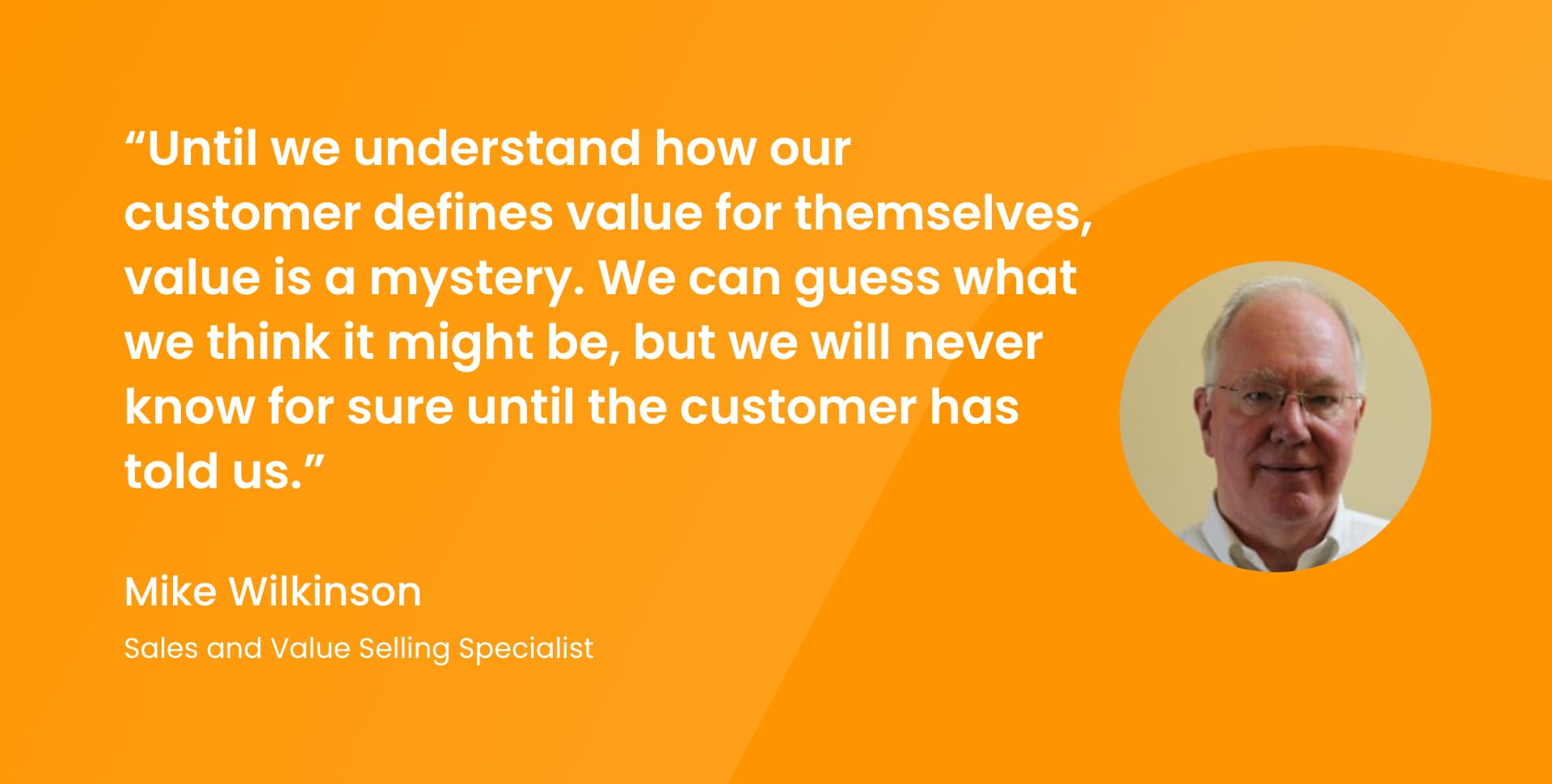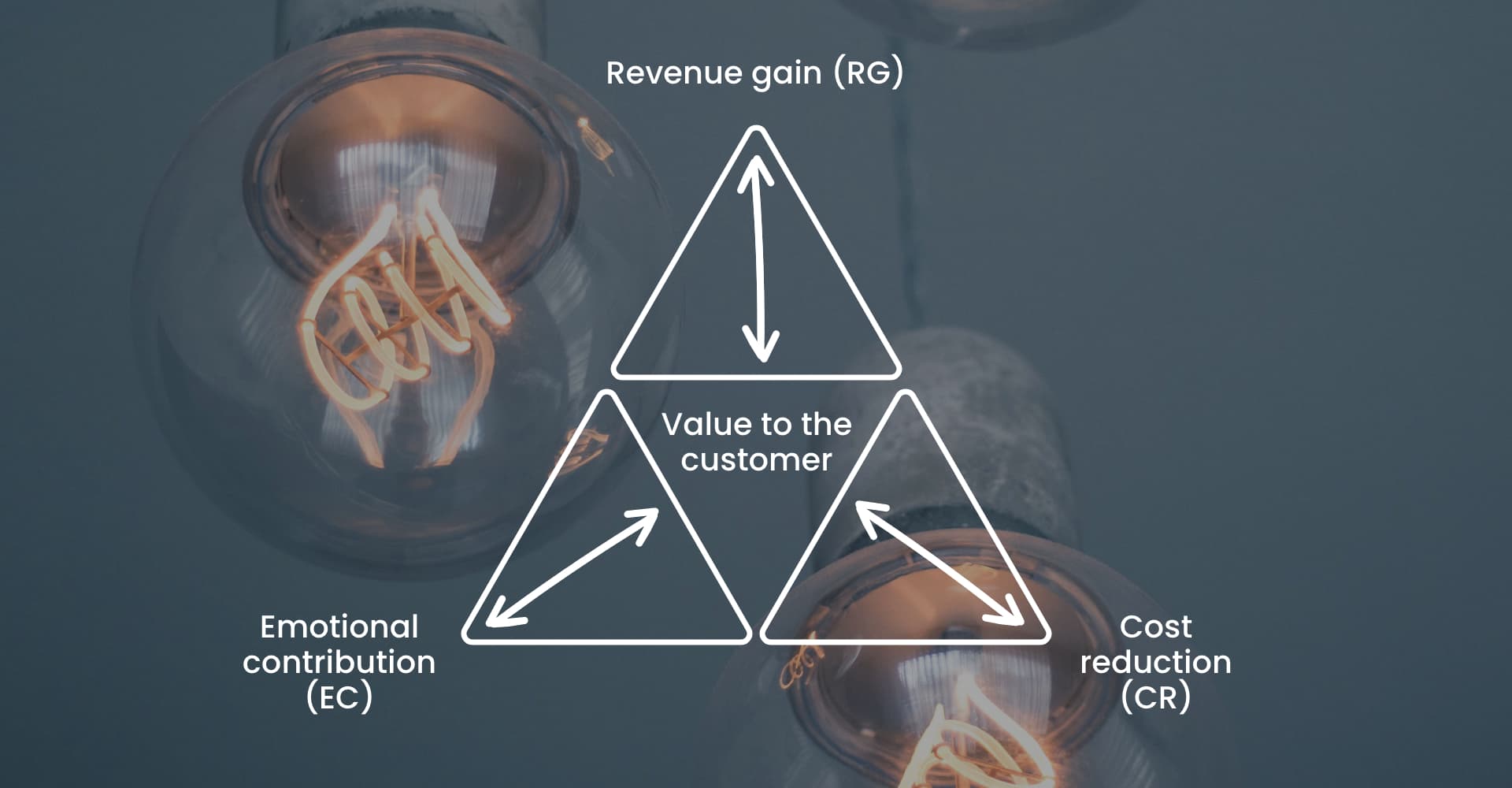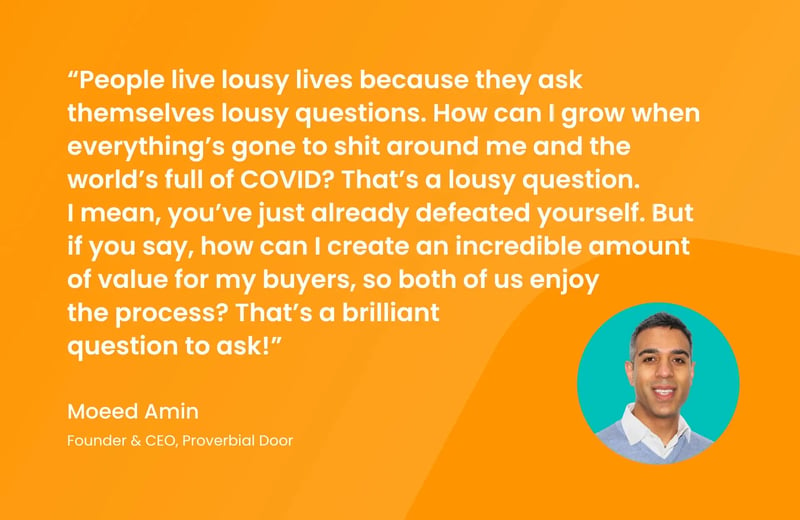Sales is all about engagement, empathy, connection, understanding, creating value, and solving problems. And detective work — good salespeople are good detectives as well.
If you want to get the right person into a meeting, you have to get their attention and be hyper-relevant in how you communicate and deliver value. You need to collect data and truly understand their business problems, ensuring you don’t mistake the symptoms for the cause.
Gong analyzed over 800,000 recorded sales calls and discovered that sales reps who used slides during their first meetings had a 17% lower likelihood of getting a follow-up call. Slides suggest that there will be a presentation, not a conversation. Buyers want to be heard and understood, so you need to identify and understand the problem before you can claim to have the solution to help.

What is value?
Before delivering value, you need to understand and define what value actually is.
Value selling expert Mike Wilkinson points out that ‘value’ is a word that everybody uses. In a business context, every other word is about value, and we use the term assuming that the other person understands what we mean by it.
There are many definitions of what value and value selling are. The problem with these definitions is that they are based on assumptions that value is based purely on the product's benefit. They fail to realize an essential thing: value is defined by your customer, not you. The definition of value may slightly change, but that element of constantly increasing value will last forever.

The Value Triad© is a widely used approach that helps identify the three fundamental component areas of value.
- Revenue gain: How does your product or service help your customers improve their revenue or performance?
- Cost reduction: How does your product or service help your customer reduce their costs?
- Emotional contribution: This element focuses on relationships and your credibility or reputation in the eyes of your customers that will enable you to build trust (or not).
In a sales environment, you want to understand the elements of the Value Triad that are important to the prospect and flex your value model to put the right level of ingredients from revenue gain, cost reduction, and emotional contribution.

Biggest mistakes of value selling
1. Defaulting to a discount — Buyers will always tell suppliers they are too expensive because they have learned from experience that a supplier’s first reaction is to drop the price. But what if you didn’t have to discount to win business?
Getting out of the discount default mentality is difficult. You need to be confident enough to look a prospect in the eye and say, “no, we are not too expensive; we’re probably not expensive enough for the value we deliver.” To build that confidence, you need to communicate value effectively. If you can’t do that, you’ll almost always end up discounting.
2. Believing product is a commodity — Customers don’t simply buy your product. They buy the entire purchasing experience, and the product itself is just part of it.
If you can’t differentiate through your product, you have to look at how you can differentiate in other business areas. Every individual in an organization adds value to the unique experience, be it service delivery, support, or onboarding.
3. Focusing on presenting your product rather than understanding the customer first — Too many sales calls begin with the seller launching straight into a presentation about the product without actually understanding what the customer wants. A lot of organizations claim their product or service is a solution.
Remember that a solution is an answer to a problem. If you don’t understand the customer’s problem, you don’t have a solution.
4. Failing to solve the value mystery — It’s important to realize that your customers define value, not you. There are four key steps to follow in a value selling process:
- Quality assessment — Don’t invest time, money, and effort in pursuing prospects that have no chance of converting. Keep your sales pipeline relevant!
- Value discovery — Understand the issues your prospects face. What are the challenges, problems, and opportunities they have? What are the pains and gains, and the impact on their business of failing to address them or taking advantage of them? Help them understand their problems and the need to do something about them.
- Value demonstration — The opportunity for you to demonstrate that your product does what the customer wants to be done. Demonstrate through a value proposition that resonates with the customer. They need to look at your solution and feel that no other ticks all the boxes quite like yours.
- Value delivery — Once you’ve acquired the customer, you must deliver on the value promise.
5. Thinking that it’s all about the sales team (more about this in the next chapter) — Value-based selling is a team effort. Everyone contributes to providing value to customers, regardless of their position in the organization, so they need to understand, create, and deliver customer value.
6. Failing to communicate and capture your value — Customers don’t buy your products but the solution they fix. Learn to communicate your product’s value, don’t focus on the features but on the actual benefits.
7. Not having an agreed sales process — Customers will always have objections. The easiest way to learn how to handle them is by having a sales process you can follow.
Ask (the right) questions
Time is a commodity. You can look at your schedule and conclude that you’ve never been this busy. You’ve got so many meetings with prospects and suppliers. But you’re not the only one with a busy schedule. Your prospects are also drowning in meetings.
There’s a short window of opportunity to deliver value in a meeting, so asking the right questions is essential. One of the most remarkable skills is the ability to ask powerful questions because asking “What keeps you up at night?” just doesn’t cut it anymore.

Your conversations and interactions with prospects can make or break a deal. Jason bets on being personal, a much-needed skill these days. You need to be able to study and listen to your prospects. What are their interests? What are their social media posts like? How do they communicate?
A good question to start with is, “What is the best way that I can deliver value?” Asking that question as a rep allows you to be seen differently. The prospect will feel heard and listened to, and they’ll hopefully tell you what they need. And if you deliver, you’ll be considered trustworthy, authentic, and valuable.
Sometimes a simple question goes a long way. “How can I help you today?” They are not going to say, “Oh, I don’t need any help!” If they do, you’ve just saved yourself a lot of time.
At the end of the meeting, you can also ask your customers, “Did you enjoy your time? Was this an hour well spent?” If you get a negative response, you can further investigate what you could have done better.
The organic value of branded communities
You’re probably part of an online community, or ten, whether a LinkedIn group for sales professionals or a subreddit for people who want to photoshop arms onto birds.
Branded online communities bring professionals together around a shared, organization-based experience or purpose for collaboration and growth. These communities can provide some precious insights into (potential) customers’ preferences and needs. They can increase customer retention, improve reputation, and of course, generate new leads for the business.
At lemlist, Nadja and her team created a closed Facebook group called “The Sales Automation Family,” an excellent opportunity to communicate with the users directly. The group was born out of the need to talk to current and potential customers more but turned into an indispensable resource for the business and the members, with nearly 20,000 members today.
The community focuses on cold emails, sales automation, and growth marketing, with members sharing nifty growth strategies and outbound lead generation. While the company is giving (and receiving!) value and helping people, the group also serves as a source of potential hires and sales. Now that’s a win-win situation!




